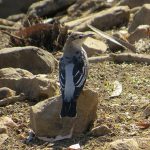WHITE-WINGED TRILLER
The White-winged Triller: A Songbird of the Australian Bush
Among the mosaic of Australian woodlands and open forests, a small but striking bird flits through the leaves—the White-winged Triller (Lalage tricolor). With its bold black and white plumage and its enchanting voice, it captures the attention of both birdwatchers and casual observers alike.
Visual Description
Imagine a bird just a little larger than a sparrow, perched lightly on a slender branch. The male White-winged Triller wears a dramatic suit:
- Head and back: Deep, velvety black
- Wings: Crisp white patches, starkly contrasting with the black
- Underparts: Clean white, accentuating the boldness of its wings
In comparison, the female is more subtly adorned:
- Plumage: Warm brown and grey tones, with streaked underparts
- Wings: Still marked with white, but less pronounced than the male
This contrast helps the female blend with the dappled light of the bush, especially when nesting.
Habitat and Distribution
The White-winged Triller is adaptable, thriving in a range of environments across much of mainland Australia. You might encounter it in:
- Open eucalypt woodlands
- Dry forests
- Scrublands
- Occasionally in parks and gardens
During the warmer months, these birds are more widespread, often moving south for the breeding season and retreating north to warmer areas in winter.
Feeding Habits
A day in the life of the White-winged Triller is a search for food amongst the trees. Its diet is almost exclusively animal-based:
- Insects: Beetles, caterpillars, grasshoppers
- Spiders and other small invertebrates
Watch as it flits through the canopy, sometimes pausing to snatch an insect mid-air or delicately picking prey from leaves and bark. The soft rustle of its wings and the faint crackle of leaves are often the only signs of its presence.
The Song of the Triller
As the sun rises, a melodious sequence of whistles and trills fills the air—a signature of the White-winged Triller. Its song is both sweet and complex, resonating through the bush:
- Whistles: Clear and vibrant, often repeated in rapid succession
- Trills: A rolling, musical sound that can carry over long distances
These vocalisations are especially prominent during the breeding season, serving to attract mates and define territories.
Conservation and Human Connection
While the White-winged Triller is currently considered secure, its reliance on healthy woodland habitats means it is indirectly affected by land clearing and habitat fragmentation.
Why does this matter?
- The presence of these birds is a sign of a balanced ecosystem.
- Their songs enrich our experience of the Australian bush, providing a living soundtrack to our wild spaces.
How can we help?
- Preserve and restore native woodlands and forests
- Support conservation efforts that protect insect-rich habitats
A Story to Remember
Picture yourself standing in a sun-dappled woodland, the scent of eucalyptus in the air. Above, the flash of white wings catches your eye, and a cascade of music follows. The White-winged Triller, with its vivid markings and joyful song, offers a reminder of the beauty and complexity of Australia’s natural heritage—a song not just for its own kind, but for all who pause to listen.
Quick Facts Table
| Feature | Description |
|---|---|
| Size | About 15–18 cm |
| Diet | Insects, spiders, small invertebrates |
| Habitat | Woodlands, forests, scrublands |
| Song | Series of whistles and trills |
| Conservation Status | Least Concern (but affected by habitat loss) |
Final Thought
By appreciating and protecting birds like the White-winged Triller, we safeguard not just a species, but the intricate web of life that makes Australia unique. Their presence is a gentle invitation to look closer, listen deeper, and cherish the wild chorus that surrounds us.

